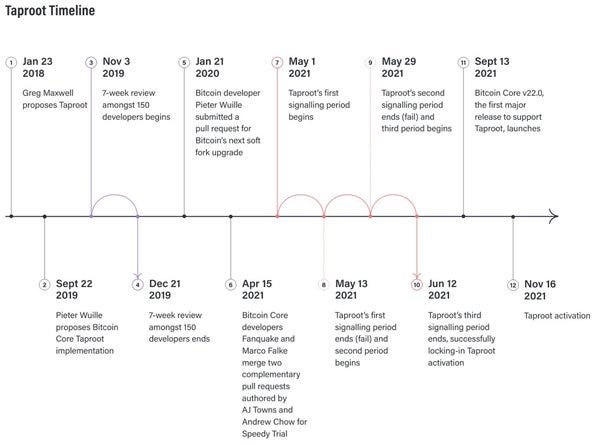Taproot: Bitcoin's big upgrade adds more privacy and better scalabity
Bitcoin recently got its biggest upgrade yet, and the first one since SegWit rolled out in 2017. But what is Taproot, and why is it a significant step forward?
July 2017 marked the end of the “block size civil war”, a heated debate about how Bitcoin should scale to achieve what Satoshi et al. set out to pull off in the early days (aka “digital cash”). Some said Bitcoin’s block size of 1MB is way too small and costly to facilitate the transaction amount needed for daily payments. Others said increasing the block size makes running full nodes and mining impossible for non-industrial players and, therefore, will hurt Bitcoin’s decentralisation.
Camp small blocks won and implemented their vision of how Bitcoin should scale in the main Bitcoin (BTC) client. Camp big blocks created Bitcoin Cash (BCH), which has since then seen even more disputes and forks.
The small blocker’s solution was an upgrade called SegWit, which - is very simplified terms - enables Bitcoin’s blocks to cram in more data without increasing the block size itself. This is achieved by segregating the digital signature from a transaction, which accounts for around 65% of the space in a given transaction (that’s why it’s called Segregated Witness).
Enter Layer 2: Lightning Network
SegWit was also the first step to enable “Layer 2 solutions” for Bitcoin. Imagine the main Bitcoin blockchain as a highway that is already pretty crowded, with many huge trucks. Driving on this highway with a fast sports car would be possible, but no fun at all. Now imagine that you could add another highway on top of the main one, with as many lanes as you want, so you can go super fast with your sports car, with a very low or even no extra fee for doing so.
This is what Bitcoin’s Lightning Network (LN) is trying to pull off. Instead of using the main Bitcoin blockchain, which is secure but tends to be slow and expensive, you can switch to a faster but less secure payment rail. Unfortunately, while LN allows for cheap and nearly instantaneous micro payments, it also brings some drawbacks, mainly that you lose some of the trustlessness that’s so important in Bitcoin’s core philosophy.

Enter Taproot: 3-in-1 upgrade for more privacy and scalability
Now that we covered SegWit and Lightning let’s look at Taproot, which can be seen as the next evolutionary step in Bitcoin’s development. Again, I need to oversimplify things a bit not to bore you to death with technicalities. Taproot was activated on November 14 at Block 709632.
Taproot is essentially the code name for a package of three upgrades or Bitcoin Improvement Proposals (BIPs):
BIP340 (Schnorr): “Schnorr Signatures” are a faster, more secure and less data-intensive way to authorize transactions. In simple terms, this allows multi-signature transactions to behave much like single-signature transactions, making Bitcoin transactions more private without any drawbacks.
BIP341 (Taproot): The Schnorr upgrade allows the addition of Taproot, which uses Merklized Alternative Script Trees (MAST). It sounds super complicated, but in essence, it’s a further step in the direction kicked off with SegWit: more privacy by leaving less transaction info behind while also taking pressure off the Bitcoin blockchain by reducing the data footprint.
BIP342 (Tapscript): Thirdly, Tapscript adds an upgraded transaction programming language. It allows devs to implement Bitcoin upgrades more efficiently in the future.
What does the Taproot upgrade mean for Bitcoin?
There is no immediate effect, but Taproot is yet another critical step for Bitcoin’s development. Overall it means added privacy and efficiency. One important aspect is that Taproot theoretically also paves the way for increased Smart Contract capabilities, which Bitcoin critics like to point out with Bitcoin (“Bitcoin has no use-case besides a store-of-value”).
Thanks to Taproot, we will most likely see DeFi platforms built on Bitcoin soon, much as we are already seeing it with Ethereum et al. Furthermore, as the Lightning Network is expected to grow and scale more efficiently thanks to Taproot, we will also see Bitcoin’s capabilities shift from digital gold (what it already does very well) to digital cash (as it was mentioned in the Bitcoin Whitepaper).
Another exciting aspect is that the Taproot upgrade went down smoothly, with no drama involved, as we saw with SegWit. So this also marks an essential step in Bitcoin’s governance history.
PS: I’ve found the Kraken Intelligence Taproot Primer helpful to understand what Taproot is. It’s very in-depth and technical but worth checking out.
Like what you read? Subscribe and follow me on Twitter.
Photo by Zach Reiner on Unsplash.





